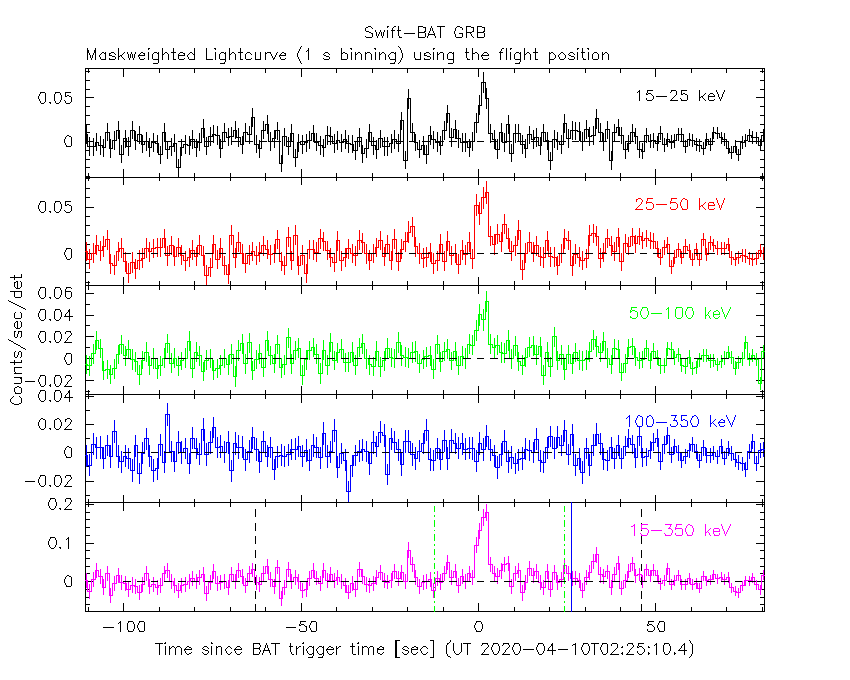
K.K. Simpson (PSU), J.D. Gropp (PSU) and N.P.M. Kuin (UCL-MSSL) for the Swift team
At 02:25:10 UT, the Swift Burst Alert Telescope (BAT) triggered and located GRB 200410A (trigger=965638) (Simpson et al. GCN Circ. 27518). Swift slewed immediately to the burst. At the time of the trigger, the initial BAT position was 77° from the Sun (5.3 hours West) and 91° from the 94%-illuminated Moon. Table 1 contains the best reported positions from Swift, and the latest XRT position can be viewed at http://www.swift.ac.uk/xrt_positions.
Simpson et al. (GCN Circ. 27518) reported the detection with UVOT of an optical afterglow. Table 2 is a summary of GCN Circulars about this GRB from observatories other than Swift.
Standard analysis products for this burst are available at https://gcn.gsfc.nasa.gov/swift_gnd_ana.html.
As reported by Laha et al. (GCN Circ. 27578),
the BAT ground-calculated position is RA, Dec = 299.644, 51.745 deg which is RA(J2000) = 1
The mask-weighted light curve (Figure 1) shows several weak pulses.
The two main pulses occur at ~T-20 s and ~T+2 s, respectively, followed by some weak emission that lasts till ~T+50 s.
The time-averaged spectrum from T-90.88 to T+50.62 s is best fit by a simple power-law model.
The power law index of the time-averaged spectrum is 1.41 ± 0.31.
The fluence in the 15-150 keV band is 1.2 ± 0.2 x 1
The results of the batgrbproduct analysis are available at https://gcn.gsfc.nasa.gov/notices_s/965638/BA/.
Analysis of the initial XRT data was reported by Gropp et al. (GCN Circ. 27523). We have analysed 16 ks of XRT data for GRB 200410A, from 86 s to 139.1 ks after the BAT trigger. The data comprise 36 s in Windowed Timing (WT) mode (the first 8 s were taken while Swift was slewing) with the remainder in Photon Counting (PC) mode. The enhanced XRT position for this burst was given by Goad et al. (GCN Circ. 27522).
The light curve (Figure 2) can be modelled with a series of power-law decays. The initial decay index is α=4.2 (+1.7, -0.7). At T+160 s the decay flattens to an α of 0.41 (+0.12, -0.14) before breaking again at T+5741 s to a final decay with index α=0.98 (+0.12, -0.08).
A spectrum formed from the PC mode data can be fitted with an absorbed power-law with a photon spectral index of 2.07 ± 0.15. The best-fitting absorption column is 3.0 ± 0.6 x 1
A summary of the PC-mode spectrum is thus:
Total column: 3.0 ± 0.6 x 1
Galactic foreground: 2.2 x 1
Excess significance: 2.4 σ
Photon index: 2.07 ± 0.15
The results of the XRT team automatic analysis are available at http://www.swift.ac.uk/xrt_products/00965638.
The Swift/UVOT began settled observations of the field of GRB 200410A 104 s after the BAT trigger
(Kuin and Simpson GCN Circ. 27532).
A source consistent with the XRT position (Goad et al. GCN Circ. 27522) is detected in the initial UVOT exposures.
Table 3 gives preliminary
magnitudes using the UVOT photometric system
(Breeveld et al. 2011, AIP Conf. Proc., 1358, 373).
No correction has been made for the expected extinction in the Milky Way
corresponding to a reddening of

Figure 1. The BAT
mask-weighted light curve in the four individual and total
energy bands. The units are counts

Figure 2. The XRT light curve.
Any data from a crosshatched region are not included in the fit.
| RA (J2000) | Dec (J2000) | Error | Note | Reference |
|---|---|---|---|---|
| 1 |
+51°46'53.0" | 0.6" | UVOT-initial | Simpson et al. GCN Circ. 27518 |
| 1 |
+51°46'53.7" | 1.4" | XRT-final | UKSSDC |
| 1 |
+51°46'50.8" | 1.9" | XRT-enhanced | Goad et al. GCN Circ. 27522 |
| 1 |
+51°44'40.9" | 2.9' | BAT-refined | Laha et al. GCN Circ. 27578 |
| Band | Authors | GCN Circ. | Subject | Observatory | Notes |
|---|---|---|---|---|---|
| Optical | Lipunov et al. | 27517 | Swift GRB200410.10: Global MASTER-Net observations report |
MASTER | |
| Optical | Jelinek et al. | 27520 | Ondrejov D50 afterglow confirmation | D50 | detection |
| Optical | Kumar et al. | 27603 | Optical upper limit | Nainital | upper limits |
| Optical | Steele et al. | 27621 | Liverpool Telescope First Hour Observations |
Liverpool Telescope | light curve |
| Gamma-ray | Cannady et al. | 27584 | CALET Gamma-Ray Burst Monitor detection | CALET |
| Filter | Exp(s) | Mag | ||
|---|---|---|---|---|
| white | 104 | 254 | 147 | 19.51 ± 0.14 |
| v | 5051 | 6869 | 396 | 21.23 ± 0.90 |
| b | 572 | 1519 | 98 | 19.61 ± 0.32 |
| u | 317 | 567 | 246 | 20.39 ± 0.37 |
| w1 | 696 | 1294 | 57 | >19.8 |
| m2 | 671 | 1220 | 57 | >20.0 |
| w2 | 622 | 1270 | 57 | >19.9 |
Table 3. UVOT observations reported by Kuin and Simpson (GCN Circ. 27532). The start and stop times of the exposures are given in seconds since the BAT trigger. The preliminary detections and 3-σ upper limits are given. No correction has been made for extinction in the Milky Way.
April 23, 2020